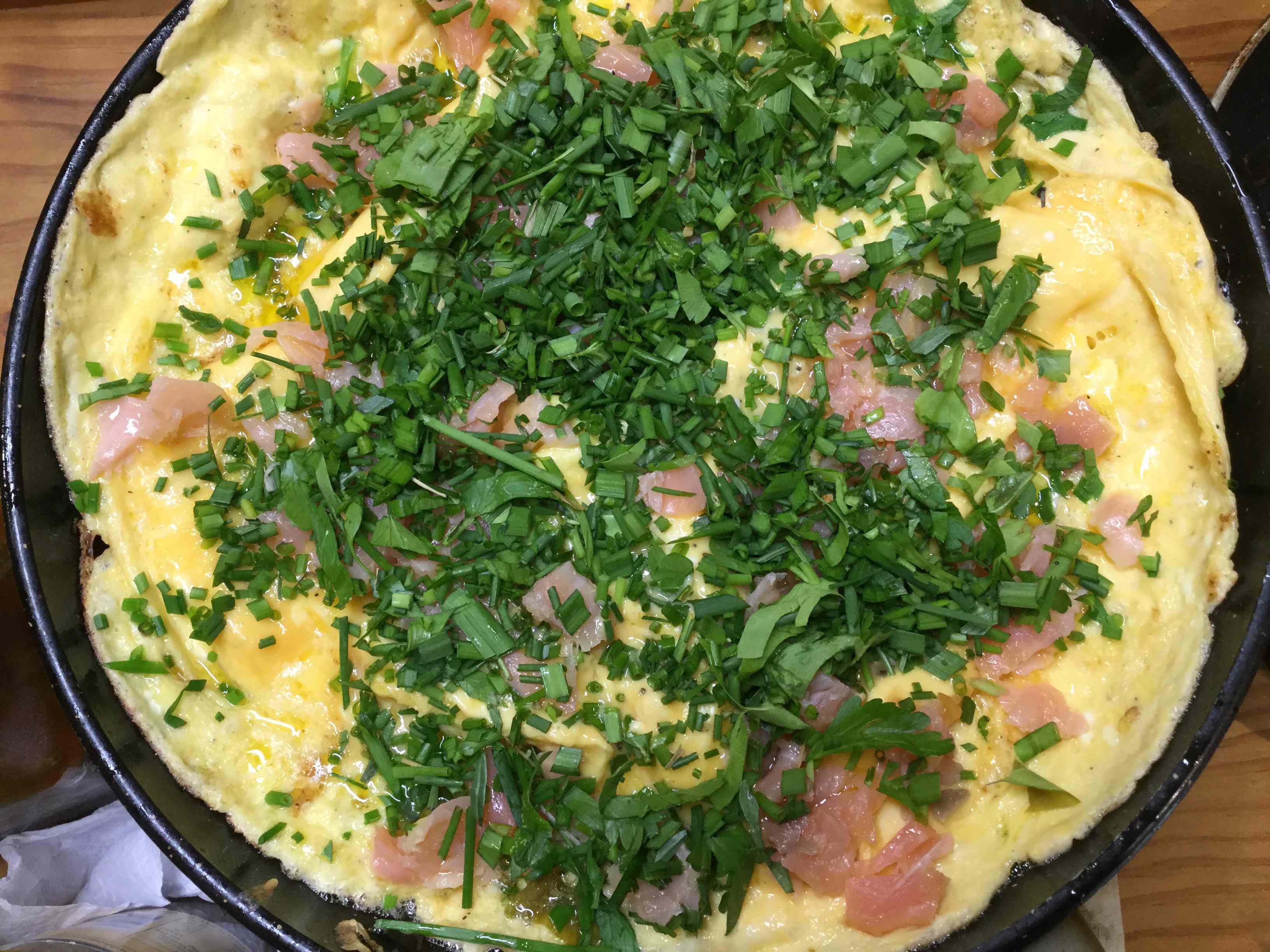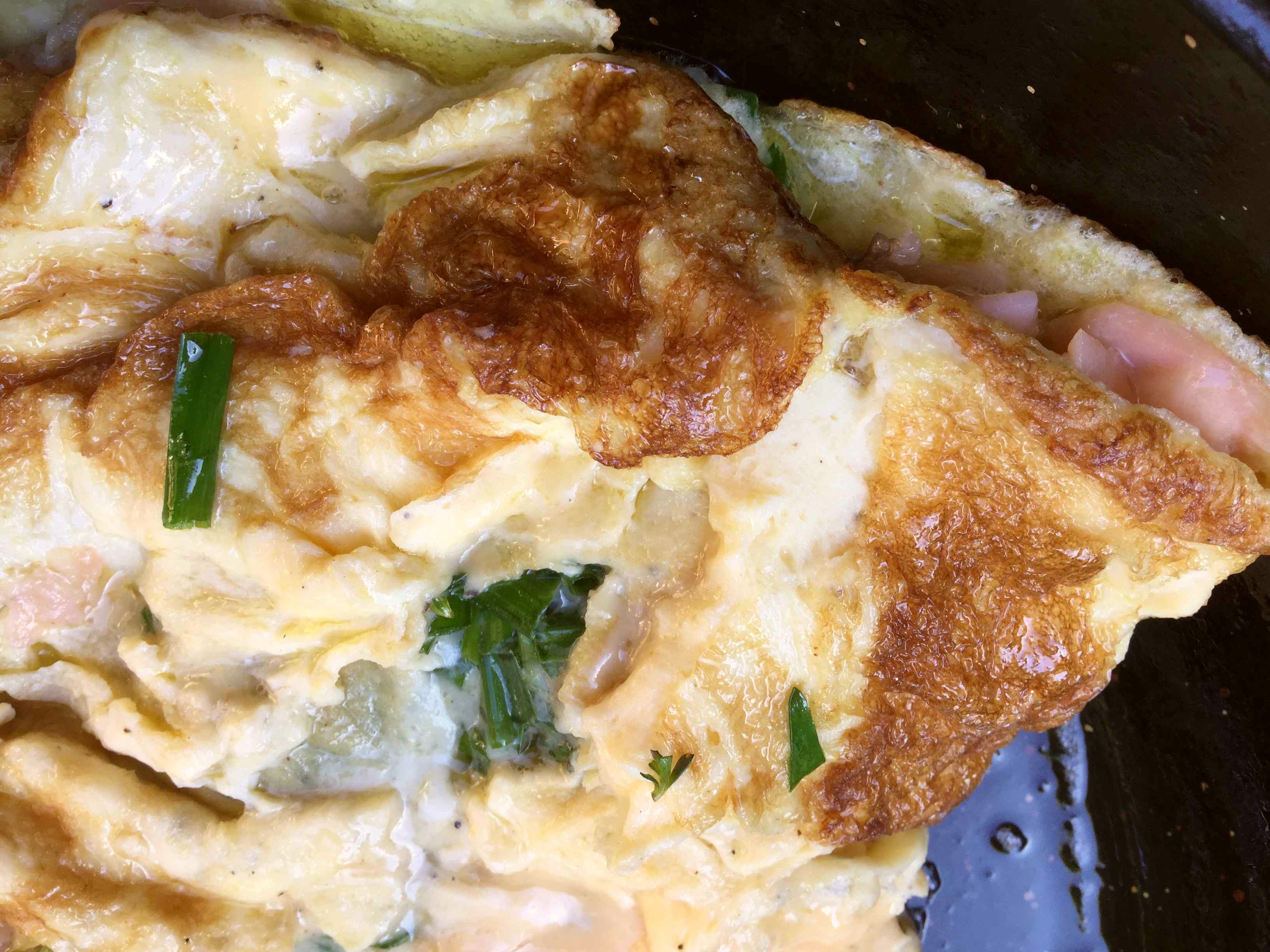This post is from an article we wrote for Club Marine magazine in 1998. Except for the food shots, the photos date from that period too.
(Use the Print button at the top of this page for a hard copy or pdf of the recipe in this post.)
Remarkable site
Mont Saint-Michel is one of France’s most famous landmarks and thus one of its top tourist destinations. Built on a small rocky island just off the Normandy coast in north-west France, it is accessible by a short land bridge. The abbey and monastery at the top are accessible by winding streets and stairs. From the top you can see the impacts of the huge 14 metre tides when the water recedes. The salty marsh lands in the vicinity produce highly sought after lamb. However, there is another foodie attraction based around eggs!
La Mère Poulard’s omelettes
We visited Mont Saint-Michel in the mid 1990s. Apart from wishing to view its extraordinary location, we also wanted to visit La Mère Poulard restaurant. Although she died about 70 years before that, Mère Poulard’s famous omelettes still lived on then (and still do in 2017). As we entered the restaurant that carried on her mystique, we ogled at burly cooks, with beefy forearms, hand whisking eggs to frothing proportions to be cooked as giant souffle-like omelettes in long-handled pans over large open fires.
According to Elizabeth David, there was no mystery to Mère Poulard’s omelettes: nothing except good ingredients, whisked together. But there is no doubt, that an omelette ten centimetres or more thick, when folded over in half, is rather imposing. When it arrives at your table, you are convinced the souffle-like mixture oozing from the centre will be uncooked. Yet it isn’t. Instead, you are struck by its extraordinary lightness and its smokey, buttery flavours. You sense a certain mystery, a mystery we won’t attempt to emulate here. Perhaps the egg whites and egg yolks are frothed separately, then combined before cooking?
The same type of omelettes are still being served and the recipe is still a secret. Following is how we make our omelettes.
Omelette aux fines herbes
Omelettes are a quick, convenient and delicious dish. Most people have their own preferred method. Ours is based around the cooking “oil” of a mixture of both butter and olive oil being very hot before adding the eggs, and using just a handful of chopped fresh herbs for flavouring. (Below we give the option of adding smoked salmon or other ingredients.)
We started using this method some years ago after watching an energetic, middle aged lady make omelette after omelette for the lunch-time crowd at a Melbourne city hotel. She had a saucepan of hot cooking “oil” at the ready on the stove: it may have been pure oil, it may have been clarified butter or it may have been a mixture of butter and oil. Each omelette was made in the space of a few minutes of being ordered. She would place a frying pan on the stove to heat through. Then crack open, and quickly whisk, the required number of eggs, with a dash of other ingredients. Then ladle a small amount of cooking oil into the now hot pan, to splash and crackle. Into this she would quickly pour the beaten eggs to spit and sizzle. Later, a few deft movements with a spatula allowed the uncooked egg to run to the base of the pan, for some more spit and sizzle. A sprinkling of herbs on top, a slide with a half flip onto a plate, then off to the waiting customer. Her omelettes were clearly a lunchtime draw card: Melbourne’s Mère Poulard.
When we explained our method of combining butter and olive oil to a French gourmand, he was horrified, insisting that it was one or the other, and that it was inconceivable to combine the two. He has since been converted.
Butter burns at a lower temperature than oil. Alternatively, by adding it to oil, it seems unclarified butter can be taken to a higher temperature, losing few of the buttery flavours. Under high heat, the omelette takes on a crisp, browned texture as the eggs soak up all the oil and butter, adding a distinctive flavour.
The best way to experience this oil-butter infusion is to keep the other flavourings to a minimum. “Fines herbes” can mean a single herb or a mixture of herbs, normally parsley, chives, chervil and French tarragon (which has a slight aniseed flavour, unlike the inferior Russian tarragon). Basil by itself is also delicious. Wash and dry these, and coarsely snip or chop before sprinkling over the omelette surface. Obviously, the better the eggs, the better the omelette. If you like your omelettes fluffy, use an electric beater to develop a more frothy mixture, or beat the egg whites separately from the egg yolks and then combine.
Alter the ingredients as required but, while we occasionally make a large one, making omelettes in smaller quantities is recommended. We don’t have any special frying pan labelled as “the” omelette pan, but we generally use a non-stick one. If you use a non-stick frying pan, you could use less “oil” but then you miss out on some lovely flavours. Use this recipe as a base for your own experiments.
Ingredients (for one or two to share)
- 3 large, quality free-range eggs
- 3 tbsps full cream milk
- salt and pepper to taste
- 1 1/2 tbsps extra virgin olive oil
- 1 1/2 tbsps butter
- 2 to 3 tbsps of one or more fresh herbs, coarsely chopped
- (Optional: 1/2 cup chopped smoked salmon, ham or other flavourings)
Method
Place the eggs, milk and salt and pepper in a bowl. Use a fork (or whisk) to beat the eggs and combine all the ingredients, building up a little extra volume and generating a slight froth around the edge of the bowl.
Place a frying pan of 25 cm or thereabouts over high heat. Add the oil, and when hot (but not smoking) add the butter. Watch the butter in the pan: it should not change colour to brown or black. As it stops spluttering and sizzling tilt the pan at different angles to coat the base and sides.
Quickly beat the egg mixture one more time, pour into the frying pan, then tilt and roll around again to coat the bottom with egg mixture. Cook over high heat, and after a minute or so, use a fork or spatula to drag some of the cooked egg to the centre, enabling the uncooked egg on top to run underneath; do this at three or four places around the edge of the frying pan, tilting the pan if required.
Don’t overcook the omelette; the top should be quite moist, but not runny. While still creamy, sprinkle over the chopped herbs, fold over and slide the omelette onto a warmed plate. (If you are using smoked salmon or similar, before the top begins to set and minute or so before you would add the herbs.) Serve with hot buttered toast.
Equipment: Suitable frying pan. Bowl and whisk.
Difficulty: Not difficult (2/5), five to ten minutes preparation.
Serve: Serves one or two people for breakfast or as a light snack or meal.
Following are two photos of a smoked salmon omelette.













